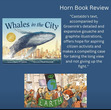Nancy F. Castaldo's Blog, page 14
October 11, 2017
Zoo Scientists to the Rescue - An Interview with Patricia Newman and Annie Crawley
Hello to Patricia Newman and Annie Crawley, author and photographer of Zoo Scientists to the Rescue. Thank you both for answering some questions today for us about this important new title.
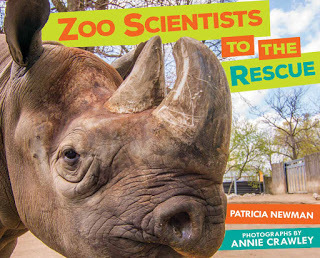
1. What inspired you to write this book, Patricia?
When my niece was in fifth grade, she told me about a persuasive essay she had to write on zoos. The information the teacher gave the class was almost all anti-zoo and as the mother of a zookeeper, I knew she didn’t have all the facts. Granted, not all zoos have high standards, but the scientific inquiry and conservation projects sponsored by AZA-member zoos educate visitors, promote the captive breeding and reintroduction of endangered species into the wild, and bring their sophisticated lab know-how to the field to preserve wildness. Those were the kinds of conservation efforts I wanted to share with young readers.
2. There are so many zoos working on conservation programs. How did you select the ones that appear in this book?
The zoo animals and the scientists that appear in Zoo Scientists to the Rescue meet a specific set of criteria. First, they are from zoos willing to cooperate with us as a creative team. Not all zoos are willing to work on outside commercial ventures, and some charge hefty fees to interview their scientists. Others charge steep licensing fees to photograph or write about animals in their collections.
Second, the zoos had to be large enough to employ scientists conducting original research. Many small zoos do not have laboratories and do not have the resources for research.
Third, the animals and the scientists’ work had to match one of the three ways zoos promote conservation: education, captive breeding and reintroduction, and studying wildlife in its native habitat. These three pieces form the backbone of the structure in Zoo Scientists to the Rescue.
And lastly, we wanted to write about animals that kids could connect to emotionally. In the zoo world, they are called charismatic megafauna.
When we think about all the pieces that had to fall into place to make this book work, we feel like we achieved a minor miracle!
3. The photographs are engaging and create an intimate look at these species. What challenges did you face, Annie, in taking them for the book?
The two biggest challenges were time and budget. When you hold a book in your hands, you do not often think about how it went from imagination to creation. Patti and I traveled to all three locations to interview the scientists. In addition, I needed to photograph the animals, labs, breeding facility, and any and all locations and activities that would complement the publication. We have to pay for our travel, hotel, meals, car rentals, etc. and we had to choose a time when we both could go around the dates the zoos/scientists gave to us.
When we visited Colorado, we were caught in a blizzard and didn’t even know if we were going to be able to make it to the Cheyenne Mountain Zoo or some of our other planned shoot locations. We literally traveled to the zoo in a blizzard. Lucky for us, the black-footed ferrets were inside the facility and we were able to make our appointment!
I grew up at the Lincoln Park Zoo in Chicago. So for me, I was facing extreme self-pressure to be able to document the story of the black rhinos and Dr. Rachel Santymire. I had no idea what kind of access we would have, nor if the weather would cooperate. I allotted for 5 days of shooting and in the end really had 2 days as weather interfered. In order to photograph/film the rhinos, you have to wait for them to be outside. So I stood with my camera observing and documenting the rhinos. They like heat and in the week I was in Chicago the weather went from 80 degrees to 40 degrees overnight and so the rhinos decided to stay inside. Fortunately, Rachel and the entire team were incredible to work with. They were very patient. To get a great, memorable shot you must know behavior of the animal and their character. This comes with time, asking questions, understanding the subject, and the right lighting. Being able to predict your shot helps as well. The trainer helped me photograph Maku by keeping him close with some treats. There is also a lot of waiting. Rhinos mark territory with urine so I found myself waiting to photograph/film until they would relieve themselves. I also had to wait until Maku needed to pooh. Rachel’s chapter is called Feces Saves Species, so I felt the need to capture Maku pooping and his trainer taking samples for Dr Santymire in the lab. You asked me about challenges, I guess none of the documentation part I really consider a personal challenge. I love being in the field, meeting the animals, figuring out how to capture their character and everything about creating an image. I guess another challenge was to shoot both photo/video as we like to create a trailer and other bonus materials to accompany the books we create together.
I travel quite a bit for my work and made sure to visit every zoo I could that had the species from our book. In Australia at the Melbourne Park Zoo they have a phenomenal orangutan exhibit and have huge educational outreach to pressure companies to use only environmentally friendly (aka orangutan friendly) palm oil. A few of the images from my time spent at the Melbourne Zoo made the cut which made me really happy. It is not one zoo making a difference, it is all zoos working together to educate and inspire the often-unknowing public about the environmental issues the animals face.
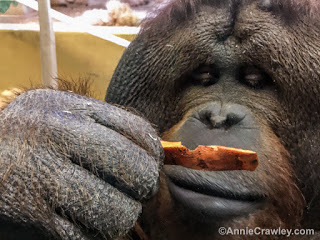
As Patti wove the scientists’ stories together, I spent my days at the Woodland Park Zoo in Seattle photographing/filming tigers, lions, penguins, zebras, hippos, and so many other animals. I live about 20 minutes away from the zoo, so by visiting daily, I was able to get to know the animals and their behavior. I talked to many of the keepers to find out when their animals were most active, or when they would be giving public presentations as they always plan those around behavior. Storytelling happens on many levels and being able to complement this book with images to take the reader into the labs, breeding facilities, and so much more is so much fun! Whatever challenges Patti and I faced on the road, they were met with laughter…and that’s why we are such a great team!
4. Did the two of you research and travel together? If so, can you share any outtakes — fun, or challenging?
When we collaborated on Plastic, Ahoy! Investigating the Great Pacific Garbage Patch, Annie traveled with the scientists on board the research vessel, the New Horizon. Patti entered the picture after the expedition had returned to dry land. As Patti wrote, Annie clarified aspects of the expedition during the writing process, and of course, worked with the editorial team in choosing the best photos to tell our story.
For Zoo Scientists to the Rescue, we worked together from the very beginning. The proposal that Patti wrote for editor Carol Hinz (Millbrook Press/Lerner) morphed from sales document to planning document. What questions did Patti need to ask in interviews? What shots did Annie need to tell our story visually?
In the three trips to the three zoos, we had a fabulous time, a lot of laughs, some frustrations, and several adventures. Most of all we learned a lot about what it takes to work together so Patti gets the best quotes and Annie gets the best shots. We’re looking forward to our next book together!
And you bet we have outtakes! How about a massive March blizzard in Denver that closed the road to the National Black-footed Ferret Center in northern Colorado, and forced us to reschedule. Annie has photos of Patti scraping thick snow off our rental car. Or how about the back story to the photograph of Maku (the black rhino at Lincoln Park Zoo) on the book’s cover. As Annie squeezed her camera lens through the bars of his enclosure, Maku turned and charged. Annie fell backwards, and we dissolved into a fit of giggles.
5. What was the most surprising thing you learned researching this book?
The three scientists in Zoo Scientists to the Rescue—Meredith, Jeff, and Rachel—were all inspired by reading about and participating in conservation projects as kids. They, in turn, hope that kids who read about their adventures will be inspired to follow in their footsteps.
Thank you both for taking the time to share Zoo Scientists to the Rescue with us. It is sure to be a hit with readers when it releases this fall. Is there a curriculum guide for teachers you can share?
Thank YOU for participating in our blog tour! We are working with grad students at San Diego State University to prepare the curriculum guide. It should be done the last week of Sept. We can send you a link when it’s ready.
We also have videos posted on YouTube you can link and share for more behind the scenes look at what we did during our travels.

1. What inspired you to write this book, Patricia?
When my niece was in fifth grade, she told me about a persuasive essay she had to write on zoos. The information the teacher gave the class was almost all anti-zoo and as the mother of a zookeeper, I knew she didn’t have all the facts. Granted, not all zoos have high standards, but the scientific inquiry and conservation projects sponsored by AZA-member zoos educate visitors, promote the captive breeding and reintroduction of endangered species into the wild, and bring their sophisticated lab know-how to the field to preserve wildness. Those were the kinds of conservation efforts I wanted to share with young readers.
2. There are so many zoos working on conservation programs. How did you select the ones that appear in this book?
The zoo animals and the scientists that appear in Zoo Scientists to the Rescue meet a specific set of criteria. First, they are from zoos willing to cooperate with us as a creative team. Not all zoos are willing to work on outside commercial ventures, and some charge hefty fees to interview their scientists. Others charge steep licensing fees to photograph or write about animals in their collections.
Second, the zoos had to be large enough to employ scientists conducting original research. Many small zoos do not have laboratories and do not have the resources for research.
Third, the animals and the scientists’ work had to match one of the three ways zoos promote conservation: education, captive breeding and reintroduction, and studying wildlife in its native habitat. These three pieces form the backbone of the structure in Zoo Scientists to the Rescue.
And lastly, we wanted to write about animals that kids could connect to emotionally. In the zoo world, they are called charismatic megafauna.
When we think about all the pieces that had to fall into place to make this book work, we feel like we achieved a minor miracle!
3. The photographs are engaging and create an intimate look at these species. What challenges did you face, Annie, in taking them for the book?
The two biggest challenges were time and budget. When you hold a book in your hands, you do not often think about how it went from imagination to creation. Patti and I traveled to all three locations to interview the scientists. In addition, I needed to photograph the animals, labs, breeding facility, and any and all locations and activities that would complement the publication. We have to pay for our travel, hotel, meals, car rentals, etc. and we had to choose a time when we both could go around the dates the zoos/scientists gave to us.
When we visited Colorado, we were caught in a blizzard and didn’t even know if we were going to be able to make it to the Cheyenne Mountain Zoo or some of our other planned shoot locations. We literally traveled to the zoo in a blizzard. Lucky for us, the black-footed ferrets were inside the facility and we were able to make our appointment!
I grew up at the Lincoln Park Zoo in Chicago. So for me, I was facing extreme self-pressure to be able to document the story of the black rhinos and Dr. Rachel Santymire. I had no idea what kind of access we would have, nor if the weather would cooperate. I allotted for 5 days of shooting and in the end really had 2 days as weather interfered. In order to photograph/film the rhinos, you have to wait for them to be outside. So I stood with my camera observing and documenting the rhinos. They like heat and in the week I was in Chicago the weather went from 80 degrees to 40 degrees overnight and so the rhinos decided to stay inside. Fortunately, Rachel and the entire team were incredible to work with. They were very patient. To get a great, memorable shot you must know behavior of the animal and their character. This comes with time, asking questions, understanding the subject, and the right lighting. Being able to predict your shot helps as well. The trainer helped me photograph Maku by keeping him close with some treats. There is also a lot of waiting. Rhinos mark territory with urine so I found myself waiting to photograph/film until they would relieve themselves. I also had to wait until Maku needed to pooh. Rachel’s chapter is called Feces Saves Species, so I felt the need to capture Maku pooping and his trainer taking samples for Dr Santymire in the lab. You asked me about challenges, I guess none of the documentation part I really consider a personal challenge. I love being in the field, meeting the animals, figuring out how to capture their character and everything about creating an image. I guess another challenge was to shoot both photo/video as we like to create a trailer and other bonus materials to accompany the books we create together.
I travel quite a bit for my work and made sure to visit every zoo I could that had the species from our book. In Australia at the Melbourne Park Zoo they have a phenomenal orangutan exhibit and have huge educational outreach to pressure companies to use only environmentally friendly (aka orangutan friendly) palm oil. A few of the images from my time spent at the Melbourne Zoo made the cut which made me really happy. It is not one zoo making a difference, it is all zoos working together to educate and inspire the often-unknowing public about the environmental issues the animals face.

As Patti wove the scientists’ stories together, I spent my days at the Woodland Park Zoo in Seattle photographing/filming tigers, lions, penguins, zebras, hippos, and so many other animals. I live about 20 minutes away from the zoo, so by visiting daily, I was able to get to know the animals and their behavior. I talked to many of the keepers to find out when their animals were most active, or when they would be giving public presentations as they always plan those around behavior. Storytelling happens on many levels and being able to complement this book with images to take the reader into the labs, breeding facilities, and so much more is so much fun! Whatever challenges Patti and I faced on the road, they were met with laughter…and that’s why we are such a great team!
4. Did the two of you research and travel together? If so, can you share any outtakes — fun, or challenging?
When we collaborated on Plastic, Ahoy! Investigating the Great Pacific Garbage Patch, Annie traveled with the scientists on board the research vessel, the New Horizon. Patti entered the picture after the expedition had returned to dry land. As Patti wrote, Annie clarified aspects of the expedition during the writing process, and of course, worked with the editorial team in choosing the best photos to tell our story.
For Zoo Scientists to the Rescue, we worked together from the very beginning. The proposal that Patti wrote for editor Carol Hinz (Millbrook Press/Lerner) morphed from sales document to planning document. What questions did Patti need to ask in interviews? What shots did Annie need to tell our story visually?
In the three trips to the three zoos, we had a fabulous time, a lot of laughs, some frustrations, and several adventures. Most of all we learned a lot about what it takes to work together so Patti gets the best quotes and Annie gets the best shots. We’re looking forward to our next book together!
And you bet we have outtakes! How about a massive March blizzard in Denver that closed the road to the National Black-footed Ferret Center in northern Colorado, and forced us to reschedule. Annie has photos of Patti scraping thick snow off our rental car. Or how about the back story to the photograph of Maku (the black rhino at Lincoln Park Zoo) on the book’s cover. As Annie squeezed her camera lens through the bars of his enclosure, Maku turned and charged. Annie fell backwards, and we dissolved into a fit of giggles.
5. What was the most surprising thing you learned researching this book?
The three scientists in Zoo Scientists to the Rescue—Meredith, Jeff, and Rachel—were all inspired by reading about and participating in conservation projects as kids. They, in turn, hope that kids who read about their adventures will be inspired to follow in their footsteps.
Thank you both for taking the time to share Zoo Scientists to the Rescue with us. It is sure to be a hit with readers when it releases this fall. Is there a curriculum guide for teachers you can share?
Thank YOU for participating in our blog tour! We are working with grad students at San Diego State University to prepare the curriculum guide. It should be done the last week of Sept. We can send you a link when it’s ready.
We also have videos posted on YouTube you can link and share for more behind the scenes look at what we did during our travels.
Published on October 11, 2017 08:25
October 3, 2017
40 Gallons of Sap to Make 1 Gallon of Syrup -- Research to Book
It takes 40 gallons of sap to make one gallon of maple syrup. That's a lot of sap! It's not too different from creating a nonfiction book. It takes gallons of research to make one small book.
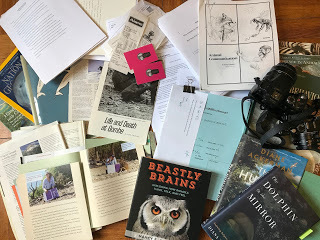
When I recently went to nErDcampNNE I brought one of my book boxes. Every book I create with Houghton Mifflin has its own box. Some boxes are bigger than others. They get filled with ticket stubs, receipts, articles, books, drafts, photo release forms, and all sorts of stuff that pertain to the writing of the book. They do NOT include all of the articles I have read online or in libraries, or the piles of books that I am not able to keep, including rare editions and such. It also does not include the hundreds of photos I take and download to my computer.
It does take many "gallons" of research for each book. Every nonfiction writer will tell you the same thing. But we enjoy it! It's a treasure hunt -- an extreme sport -- a time to EXPLORE!
There are so many ways that teachers can spur on this exciting phase of writing with students. Loree Griffen Burns, Melissa Stewart, and I discussed having students interview each other, parents, teachers, and community members. Teaching students interview etiquette and how to write questions and ask follow-up questions is part of the learning process.
Thinking of the research phase more like a quest than finding three sources for a project is the goal. Making discoveries and letting those discoveries lead to more questions and on to more discoveries is the joy we nonfiction authors feel every day.
And then after all that research we have to distill it down - just like boiling down the sap - to find the jewels we want to include in shaping the book we write.
Ask any nonfiction author about their research and you will be in for a treat!

When I recently went to nErDcampNNE I brought one of my book boxes. Every book I create with Houghton Mifflin has its own box. Some boxes are bigger than others. They get filled with ticket stubs, receipts, articles, books, drafts, photo release forms, and all sorts of stuff that pertain to the writing of the book. They do NOT include all of the articles I have read online or in libraries, or the piles of books that I am not able to keep, including rare editions and such. It also does not include the hundreds of photos I take and download to my computer.
It does take many "gallons" of research for each book. Every nonfiction writer will tell you the same thing. But we enjoy it! It's a treasure hunt -- an extreme sport -- a time to EXPLORE!
There are so many ways that teachers can spur on this exciting phase of writing with students. Loree Griffen Burns, Melissa Stewart, and I discussed having students interview each other, parents, teachers, and community members. Teaching students interview etiquette and how to write questions and ask follow-up questions is part of the learning process.
Thinking of the research phase more like a quest than finding three sources for a project is the goal. Making discoveries and letting those discoveries lead to more questions and on to more discoveries is the joy we nonfiction authors feel every day.
And then after all that research we have to distill it down - just like boiling down the sap - to find the jewels we want to include in shaping the book we write.
Ask any nonfiction author about their research and you will be in for a treat!
Published on October 03, 2017 01:00
September 12, 2017
Middle Grade Reads to Encourage Observation and Discovery
Exploring the outdoors is not just a summertime activity. Getting outside on an autumn day is a wonderful time to encourage outdoor exploration. These middle grade titles, both fiction and nonfiction, are perfect to jumpstart curiosity!
The True Blue Scouts of Sugarcane Swamp by Kathi Appelt
Maybe a Fox by Kathi Appelt
Finding Wonders by Jeannine Atkins
The Thing About Jellyfish by Ali Benjamin
The Penderwicks : A Summer Tale of Four Sisters, Two Rabbits, and a Very Interesting Boy by Jeanne Birdsall
The Wolf Keepers by Elise Broach
The Secret Garden by Frances Hodgson Burnett
Beastly Brains: Exploring How Animals Think, Talk, and Feel by Nancy Castaldo
The Fourteenth Goldfish by Jennifer L. Holm
Turtle in Paradise by Jennifer L. Holm
The Evolution of Calpurnia Tate by Jacqueline Kelly
The Curious World of Calpurnia Tate by Jacqueline Kelly
Saving Wonder by Mary Knight
Pax by Sarah Pennypacker
Untamed: The Wild Life of Jane Goodall by Anita Silvey
The True Blue Scouts of Sugarcane Swamp by Kathi Appelt
Maybe a Fox by Kathi Appelt
Finding Wonders by Jeannine Atkins
The Thing About Jellyfish by Ali Benjamin
The Penderwicks : A Summer Tale of Four Sisters, Two Rabbits, and a Very Interesting Boy by Jeanne Birdsall
The Wolf Keepers by Elise Broach
The Secret Garden by Frances Hodgson Burnett
Beastly Brains: Exploring How Animals Think, Talk, and Feel by Nancy Castaldo
The Fourteenth Goldfish by Jennifer L. Holm
Turtle in Paradise by Jennifer L. Holm
The Evolution of Calpurnia Tate by Jacqueline Kelly
The Curious World of Calpurnia Tate by Jacqueline Kelly
Saving Wonder by Mary Knight
Pax by Sarah Pennypacker
Untamed: The Wild Life of Jane Goodall by Anita Silvey
Published on September 12, 2017 02:00
September 5, 2017
Keeping Green this School Year
There are many things you can do to keep "green" this school year. I borrowed many of these ideas from NYS Department of Environmental Education.
School Supply Shopping Reuse school items left over from last year; backpacks, lunch bags, water bottle, scissors, binders, and any pens and pencils. Search for products that aren't sold with a lot of packaging, and recycle any packaging materials you can.Buy recycled paper and other items. You might even find a backpack or sneakers made from recycled materials. Buy non-toxic alternatives - look for non-toxic pens, markers, art supplies and other school supplies.Use rechargeable batteries whenever possible.School LunchesThink "reusable" when packing lunches - use reusable lunch boxes or canvas bags, sandwich containers and utensils. If not "reusable" think biodegradable. For water or other drinks, bring a reusable stainless steel bottle or bisphenol A-free (BPA-free) bottle.Pack your own lunch instead of buying foods that involve a lot of packaging. Look for bulk food items instead of those that are packaged as single servings and package them yourself in reusable containers! You'll also save money! Greening Your ClassroomEncourage your school to institute a good recycling program or expand their existing program. Compost cafeteria waste. Use both sides of paper when possible.Start a school garden!
Published on September 05, 2017 03:00
August 29, 2017
Sniffer Dog Zuma on Television - An Interview with Handler Donna Randolph
For those of you who have read
SNIFFER DOGS: How Dogs (and Their Noses) Save the World
, you already know how awesome these dogs are at their respective detection jobs. Every day they are working with law enforcement, military personnel, and private citizens to make our world a better place.
One of these awesome sniffers recently appeared in the television documentary series, American Ripper. Zuma and Donna Randolph were brought in to help the investigation of a very old case. It was such a treat for me to watch the pair at work again. I hadn’t seen Zuma in the field since I met up with her during my Sniffer Dog research in 2012.
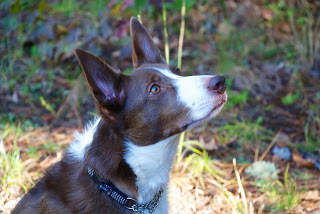 Zuma from SNIFFER DOGS (photo by author)
Zuma from SNIFFER DOGS (photo by author)
Thanks, Donna, for sharing the story of this experience with us now! Zuma has been on so many cases. How did this one, for a documentary tv investigation, compare with the others?
This was a very difficult search which I expected to yield no results. The area was affected by so many things. First, since the crime took place 120 years ago, new houses were built, the original house was moved, modern roadways were constructed, and modern utilities were installed. That made most of the area nearly impossible to search. Not only that, there were many feral (not pets but free roaming) cats living in the area and they were all interested in what Zuma was doing. In addition, many of the yards we searched were either “owned” by other dogs or they had many beautiful flower beds. We had to negotiate cat relations, dog relations, be careful not damage any flowers, and search in difficult conditions. This was by far our most difficult and stressful search ever. Being filmed while you worked added even more to our difficulties. So many different scents to work through and sort for Zuma, including working around and with the film crew, not to mention street traffic, a yard with chickens in a chicken coop, and many more distractions.
Did she have to do multiple takes for her scene?
Yes, we did. Once she discovered an actual source, they filmed it from different angles. She was very happy to perform over and over for her toy reward.
Forensic canines have the ability to find old bones, even fragments. *spoiler alert* Were you able to be on the set while the archeological team came to dig the area where Zuma alerted?
No, we were home during the dig. I wish we could have been there to help with digging and sifting. We could have worked with the archaeologist to help shrink the search area. I did know the days they were digging and I got a hint of a possible find but no details or idea of the significance. That made viewing our episode very exciting.
Has Zuma continued training every week for her job?
Zuma trains 5 to 6 times a week. However since the airing of the show she has gone almost completely deaf. So she now works on leash so we can communicate better. She is almost 12 years old and is still eager to work.
That is dedication - both on her part and yours! This was a fascinating case for Zuma. I’m sure it brought more attention to the skills of this special type of detection dog. Can you share another case that might interest young readers?
Zuma and I were able to travel to Canada. She was asked to search a battlefield for buried soldiers. At Grande Pre, she showed a group of students how Historical Human Remains can be discovered from the 1700's without digging. We used oral and written history to determine a search area to work. It was all about reading special old maps, to determine were the roads were and signage. The distance from the sign and along the older roadway were determined and that is where she searched. I love history and we were able to further make it historic by searching for these American soldiers in Canada on Memorial Day. It was a very memorable and special search for us.
Thank you, Donna and Zuma, for your dedication and amazing skills. It’s fascinating to follow your work.
You can learn more about these special detection dogs at Institute for Canine Forensics and read more about Zuma and Jax in SNIFFER DOGS (HMH) - now in paperback at your local bookstore.
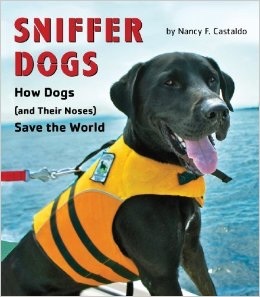
One of these awesome sniffers recently appeared in the television documentary series, American Ripper. Zuma and Donna Randolph were brought in to help the investigation of a very old case. It was such a treat for me to watch the pair at work again. I hadn’t seen Zuma in the field since I met up with her during my Sniffer Dog research in 2012.
 Zuma from SNIFFER DOGS (photo by author)
Zuma from SNIFFER DOGS (photo by author)Thanks, Donna, for sharing the story of this experience with us now! Zuma has been on so many cases. How did this one, for a documentary tv investigation, compare with the others?
This was a very difficult search which I expected to yield no results. The area was affected by so many things. First, since the crime took place 120 years ago, new houses were built, the original house was moved, modern roadways were constructed, and modern utilities were installed. That made most of the area nearly impossible to search. Not only that, there were many feral (not pets but free roaming) cats living in the area and they were all interested in what Zuma was doing. In addition, many of the yards we searched were either “owned” by other dogs or they had many beautiful flower beds. We had to negotiate cat relations, dog relations, be careful not damage any flowers, and search in difficult conditions. This was by far our most difficult and stressful search ever. Being filmed while you worked added even more to our difficulties. So many different scents to work through and sort for Zuma, including working around and with the film crew, not to mention street traffic, a yard with chickens in a chicken coop, and many more distractions.
Did she have to do multiple takes for her scene?
Yes, we did. Once she discovered an actual source, they filmed it from different angles. She was very happy to perform over and over for her toy reward.
Forensic canines have the ability to find old bones, even fragments. *spoiler alert* Were you able to be on the set while the archeological team came to dig the area where Zuma alerted?
No, we were home during the dig. I wish we could have been there to help with digging and sifting. We could have worked with the archaeologist to help shrink the search area. I did know the days they were digging and I got a hint of a possible find but no details or idea of the significance. That made viewing our episode very exciting.
Has Zuma continued training every week for her job?
Zuma trains 5 to 6 times a week. However since the airing of the show she has gone almost completely deaf. So she now works on leash so we can communicate better. She is almost 12 years old and is still eager to work.
That is dedication - both on her part and yours! This was a fascinating case for Zuma. I’m sure it brought more attention to the skills of this special type of detection dog. Can you share another case that might interest young readers?
Zuma and I were able to travel to Canada. She was asked to search a battlefield for buried soldiers. At Grande Pre, she showed a group of students how Historical Human Remains can be discovered from the 1700's without digging. We used oral and written history to determine a search area to work. It was all about reading special old maps, to determine were the roads were and signage. The distance from the sign and along the older roadway were determined and that is where she searched. I love history and we were able to further make it historic by searching for these American soldiers in Canada on Memorial Day. It was a very memorable and special search for us.
Thank you, Donna and Zuma, for your dedication and amazing skills. It’s fascinating to follow your work.
You can learn more about these special detection dogs at Institute for Canine Forensics and read more about Zuma and Jax in SNIFFER DOGS (HMH) - now in paperback at your local bookstore.

Published on August 29, 2017 07:30
August 16, 2017
Visit to The Bennington Free Library
Authors love to visit book shops. That's a given. But we also love visiting libraries. In fact, nonfiction authors LIVE in libraries. We are always visiting libraries for our research. That said, I thought I'd share some fun library visits with you, my readers! These libraries are unique and special for many different reasons. The first one I am highlighting is the Bennington Free Library in the lovely town of Bennington, Vermont.
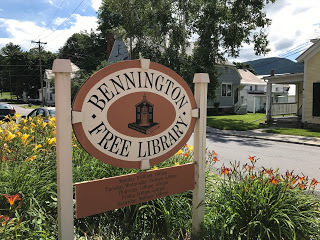
I kew this was going to be a special place as soon as I approached the door.
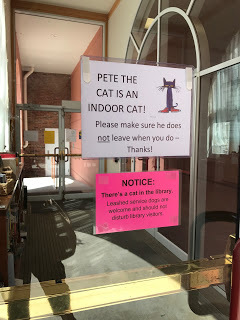
A library cat! YAY! I couldn't wait to enter and say hello to Pete!
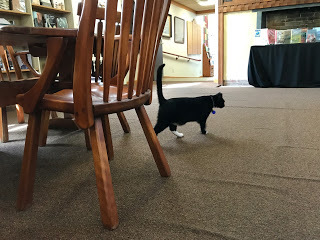
Pete was pretty busy making the rounds through the library while I was there doing some research, so I didn't disturb him.
I did spend some time chatting with the librarian at the desk in the children's room. WOW! What a great space with a great collection, including a fantastic STEM display and activities.
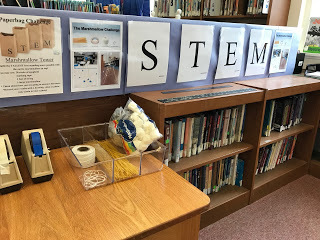
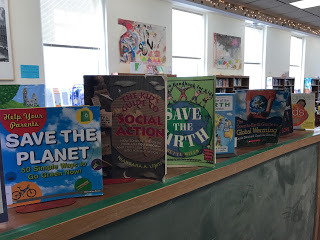
Check back as I post other wonderful library visits from around the country!
Published on August 16, 2017 10:31
July 18, 2017
Growing Patterns: Fibonacci Patterns in Nature - An Interview with Sarah Campbell
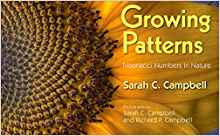
Sarah, your book, Growing Patterns, is beautiful and also informative. Can you start off by explaining what are Fibonacci numbers?
Thank you, Nancy. The Fibonacci sequence is a simple number pattern that starts with 1 and 1. To get the next number in the sequence, you add the first two numbers together. So, the third number in the sequence is 1 plus 1, which equals 2. The next number is 1 plus 2, which equals 3. Then, 2 plus 3, which equals 5. The numbers keep going higher and higher, always following the same pattern. So, the first 12 Fibonacci numbers are 1, 1, 2, 3, 5, 8, 13, 21, 34, 55, 89, and 144.
What made you decide to tackle this topic in a picture book for young readers?
As soon as my first book, Wolfsnail, was published by Boyds Mills Press in 2008, I started casting about for the next project. Initially, I thought I might write about another small animal, but the nonfiction market is already saturated with books about the animals I was considering – a butterfly, a turtle, a gecko. I knew, however, that I wanted my next book to feature the same upclose, macro photography I used to illustrate Woflsnail. When I was talking through that idea with an editor at an SCBWI conference, I said, “Maybe I could do something on patterns in nature.” Coincidently, I had recently finished reading a novel that featured Fibonacci numbers in the plot. Intrigued by something one of the characters said about the numbers being found in nature, I did some research. When some of the first examples I read about were sunflowers and pinecones, I knew I had hit upon an idea I could photograph. There was a little hesitation at Boyds Mills initially about whether Fibonacci numbers, which are typically taught in middle school, were appropriate in a picture book for elementary school readers. However, the concept of patterns is central to the early elementary curriculum, including “growing patterns,” which, after I read the term in a math curriculum document, became my title.
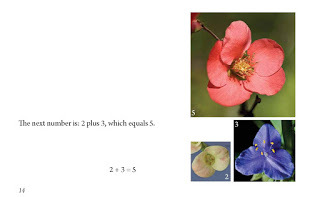
The photographs are striking. What challenges did you face in providing the images for this title?
One of the constraints I set for myself when I started writing nonfiction for kids was that I needed to be able to photograph my subjects locally. I had three small boys at the time and no time or money for traveling. All the flower images were taken in my neighborhood – some in my backyard. The hardest to get was the nautilus shell but my aunt who is a stained glass artist in South Carolina knew of a source for good shells and she sent one to me by post. The biggest challenge in making the images was figuring out how to create a visual narrative. Each image is essentially a straight-on photograph of a natural object: flower, pinecone, pineapple, shell. In contrast to the images for Wolfsnail, which were macro shots of a snail hunting for food, these Growing Patterns images did not show action. I solved this problem by using a page design that showed the same “growing” progression as the Fibonacci numbers have in the pattern. On the first page, there is one tiny photograph of a single sprouting seed. Subsequent pages show proportionately larger images with flowers that have the number of petals equal to Fibonacci numbers.
How can teachers use this book in their classroom?
My favorite way for teachers to use the book in their classrooms is a multi-disciplinary project called The Fibonacci Folding Book. The teacher uses Growing Patterns to introduce Fibonacci numbers and then the students make, write, illustrate, and share their own nature-themed books. An online video tutorial, including all the steps, connections to national standards, and student examples, is available in the FOR TEACHERS section of my website. More examples are available on my blog. Teachers can also ask students to suggest two starting numbers other than 1 to create their own growing pattern. I sometimes do this with students during school visits. We use personal white boards to do the addition required to find each subsequent number in the sequence.
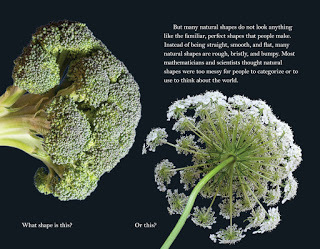
I see that your recent title Mysterious Patterns: Finding Fractals in Nature covers another great STEM theme. What is the story behind that book?
Mysterious Patterns came about because smart librarians suggested it. They had Growing Patterns in their collections and thought fractals needed a book, too.When I began the research and saw the equation for the Mandelbrot set, a fairly famous fractal, I nearly gave up. It looks like this:
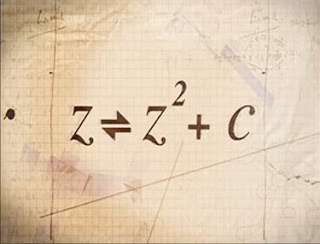
My publisher was also (understandably) nervous about whether it was right for the elementary market. More research led to my decision to use a compare/contrast structure to write the book. Fractals at their most basic are shapes. They are different from the geometric shapes (cones, cylinders and spheres) students learn in elementary school, but the fact that kids learn about these shapes in early grades meant to me that they could be introduced to fractals, a totally different kind of shape.
What are you working on now?
I am working on a book about infinty. Figuring out the photographs for this one has been a huge challenge, but I’m in a good place with them now. I can’t wait to share!
Thank you, Sarah!
If you enjoy Sarah's book, take a peek at Joyce Sidman's SWIRL BY SWIRL: Spirals in Nature. It is the perfect companion title!
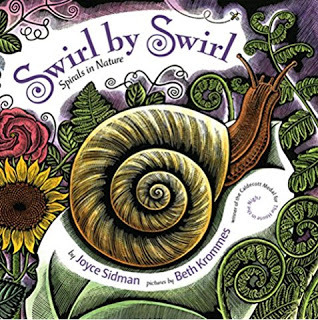
Published on July 18, 2017 06:00
July 11, 2017
SNIFFER DOGS: How Dogs (and Their Noses) Save the World - NOW IN PAPERBACK!
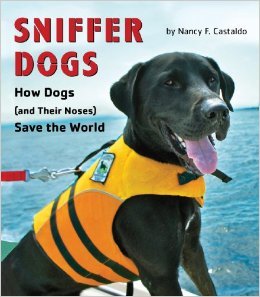
I am so very happy that SNIFFER DOGS is now available in paperback for the affordable price of $7.99, meaning that many more readers will be able to read about the amazing dogs I met writing this book. Anyone who has ever spent time with a dog knows that dogs love sniffing! They sniff out hidden food, dirty socks, and the visitor who comes to the door. But some dogs work with police officers, soldiers and even scientists to put their “sniffers” to work. Sniffer dogs make use of the amazing biology behind their noses to protect people from bombs, catch criminals smuggling drugs, or help researchers locate a hard to find snail in a forest. A dog’s nose is so sensitive that if a human could see as well as a dog could smell, we would be able to see the small letters on an eye chart from four (four!) miles away. Is it any wonder then that dogs can be trained to find missing people in piles of rubble or a certain flower blooming amongst hundreds or thousands of other smells? In Sniffer Dogs you will meet many dogs and their handlers and learn all about their jobs. Some of these dogs are raised from birth to detect blood sugar levels in their owners. Others are rescued from animal shelters and their boisterous personalities help make them excellent sniffer dogs. Featuring a balance between science and social science,Sniffer Dogs will appeal to dog lovers and science lovers alike. Reviews “An exemplary presentation of information in a lively, engaging way—readers will be left feeling awe for their canine companions and enthusiasm for their abilities.” *Kirkus – starred review“Superb coverage of the canine contribution to rescue and safety in both text and illustration, Castaldo’s book presents both the dogs and their trainers and handlers in roles involving world peril and individual handicap.” VOYA Magazine“A well-organized, thoughtfully written title that celebrates the achievements of these great dogs.” – School Library Journal“This fascinating account will leave young readers feeling wonder and gratitude for the gifts of the canine set.” Wall Street Journal“The adventurous element of search and rescue and military duty adds an edge to draw readers unnoticed by (or unwilling to be caught with) mere cute puppies.” – Bulletin“Castaldo’s excellent research and lively writing along with great dog photos make this a book kids will love, and they won’t even suspect they are learning.” San Francisco Book Review“This is a perfectly executed nonfiction book, from its appealing subject right down to its useful appendix with bibliography of books and articles, listings of web sites, places to visit, “Ways to Get Involved,” and a useful glossary. For serious dog fanciers, research report writers, and almost any school or public library, Sniffer Dogs: How Dogs (and Their Noses) Save the World is definitely “Best in Show.” BooksForKidsBlog“Finally, a title that combines all of these aspects—hook, subject, relatable elements, and design—is Nancy Castaldo’s Sniffer Dogs: How Dogs (and Their Noses) Save the World (HMH, 2014). School Library Journal – Selecting and Promoting Nonfiction in Your Library Lists and Awards**National Science Teachers Association 2015 Outstanding Science Trade Books for Students K-12 SCBWI Crystal Kite Award for NYMaine State Library Cream of the Crop ListBank Street Best Books of the Year 2015NYC Reads 365 – 5th grade listKirkus star
Published on July 11, 2017 11:34
July 7, 2017
Science is not an ending. It is a beginning.
I have been writing about our natural world for decades and for the most part my books have been far from controversial. That is until recently. I first wrote about climate change in my 2008 title, KEEPING OUR EARTH GREEN. I described real-life citizen science experiences that offered proof of a warming planet. And I included activities that could help slow it down. It is hard to believe that I wrote that book ten years ago and scientists are still having their results questioned. As our ice melts in the Arctic and now the Antarctic, and we have even seen our first climate refugees leaving their island homes, our country is debating whether climate change is a hoax.
My 2016 book, THE STORY OF SEEDS, focused on the seed crisis our planet if facing, partly due to climate change. I discussed genetically modified crops and their impact on the environment. I introduced readers to visionaries, like Dr. Cary Fowler, who are working across the globe to protect our food source.
My 2017 book, BEASTLY BRAINS, brings to light the cognitive abilities of animals, including corvids, elephants, primates, dolphins, dogs, and bees. I presented scientific studies that point to cognitive evolution and nudged my readers to think about the rights of animals that exhibit empathy and self-awareness.
All of these books talk about science. Science isn't something we need to believe in. It isn't a philosophy or a religion. It is a blending of explorative thinking and curiosity that helps us discover the world around us. For those of us who believe in a higher power, it is what helps us revel in what was created for us. Science is not an ending. It is a beginning. It can provide us with the technology to keep our houses cool in the summer, alert us to dangerous storms, help transport us, and help us live longer. There are times when science has the ability to go further than we might want it to and then we have to introduce ethics. But science has no agenda. It is simply there to be understood and explored.
I watched a video today of two congressman debating climate change and calling for a debate. As this continues the world keeps spinning and warming. I'm not sure what our Earth's future will hold for us, but it is imperative that we provide our students with critical thinking opportunities and strong science programs so that they might be able to lead us in a world that might not be as hospitable to humans in the future.
My 2016 book, THE STORY OF SEEDS, focused on the seed crisis our planet if facing, partly due to climate change. I discussed genetically modified crops and their impact on the environment. I introduced readers to visionaries, like Dr. Cary Fowler, who are working across the globe to protect our food source.
My 2017 book, BEASTLY BRAINS, brings to light the cognitive abilities of animals, including corvids, elephants, primates, dolphins, dogs, and bees. I presented scientific studies that point to cognitive evolution and nudged my readers to think about the rights of animals that exhibit empathy and self-awareness.
All of these books talk about science. Science isn't something we need to believe in. It isn't a philosophy or a religion. It is a blending of explorative thinking and curiosity that helps us discover the world around us. For those of us who believe in a higher power, it is what helps us revel in what was created for us. Science is not an ending. It is a beginning. It can provide us with the technology to keep our houses cool in the summer, alert us to dangerous storms, help transport us, and help us live longer. There are times when science has the ability to go further than we might want it to and then we have to introduce ethics. But science has no agenda. It is simply there to be understood and explored.
I watched a video today of two congressman debating climate change and calling for a debate. As this continues the world keeps spinning and warming. I'm not sure what our Earth's future will hold for us, but it is imperative that we provide our students with critical thinking opportunities and strong science programs so that they might be able to lead us in a world that might not be as hospitable to humans in the future.
Published on July 07, 2017 15:23
June 27, 2017
Did You Wear Lipstick? : Sylvia Earle, Books, and the Ocean
My daughter, an artist, just completed a piece inspired by Sylvia Earle's groundbreaking ocean research and the gender bias she received upon her return from below the sea.
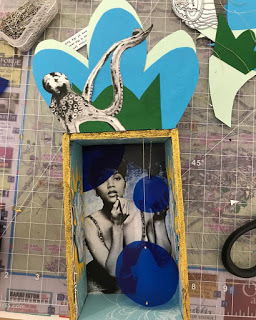
Sylvia Earle lead the first team of woman aquanauts in 1970."I took pleasure in turning questions such as 'Did you wear lipstick? Did you use a hairdryer?' into a discourse on the importance of the ocean as our primary source of oxygen," said Sylvia in an essay for the National Journal of Literature and Discussion.
Young readers can learn more about Sylvia Earle's ocean exploration in Life in the Ocean: The Story of Oceanographer Sylvia Earle by Claire A. Nivola.
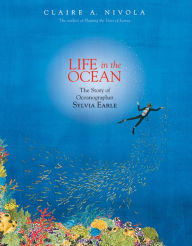
Sylvia Earle is not the only female ocean explorers. There are many others to inspire young readers.
Check out these two books -- Shark Lady by Jess Keating and Solving the Puzzle Under The Sea by Robert Burleigh.
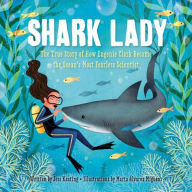
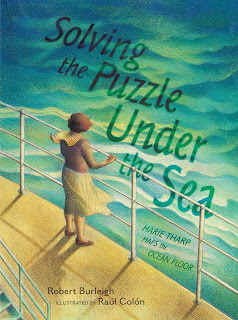

Sylvia Earle lead the first team of woman aquanauts in 1970."I took pleasure in turning questions such as 'Did you wear lipstick? Did you use a hairdryer?' into a discourse on the importance of the ocean as our primary source of oxygen," said Sylvia in an essay for the National Journal of Literature and Discussion.
Young readers can learn more about Sylvia Earle's ocean exploration in Life in the Ocean: The Story of Oceanographer Sylvia Earle by Claire A. Nivola.

Sylvia Earle is not the only female ocean explorers. There are many others to inspire young readers.
Check out these two books -- Shark Lady by Jess Keating and Solving the Puzzle Under The Sea by Robert Burleigh.


Published on June 27, 2017 07:20

